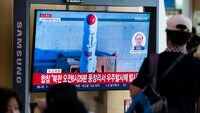North Korea fired a new type of rocket named Chollima-1 — after a mythological flying horse — about 6:29 a.m. local time Wednesday from its west coast and over South Korea’s westernmost Baengnyeong Island, according to South Korea’s Joint Chiefs of Staff.
But the projectile landed in South Korea’s western waters after an “abnormal flight” and before it could launch any object into orbit, according to officials in Seoul and Tokyo.
North Korea’s National Aerospace Development Administration said an “accident” occurred during the launch and “serious” defects caused the second stage of the rocket to malfunction.
It lost thrust midair due to engine failure and fell into the sea between South Korea and China, landing in the sea border between their exclusive economic zones.
The North Korean military would “conduct the second launch as soon as possible through various part tests,” the official Korean Central News Agency in Pyongyang said Wednesday morning.
South Korea’s National Security Council said it will continue to monitor for the possibility of an additional launch from the North.
A marine salvage operation is underway to retrieve debris from the suspected space launch vehicle that fell into the sea, the South’s Joint Chiefs of Staff said.
The South Korean Defense Ministry released photos of the recovered debris, which appeared to be a rocket part connecting the stages together. Authorities will assess the debris to collect new information about North Korea’s space technology.
The North’s space launch is considered a breach of U.N. Security Council resolutions that restrict the regime from using ballistic missile technology, which can be used for carrying warheads or civilian payloads such as weather stations.
South Korean, Japanese and U.S. officials all condemned the launch, with U.S. National Security Council spokesman Adam Hodge adding that the “door has not closed on diplomacy.”
The launch set off alarm bells — literally — in South Korea and Japan.
The 25 million residents of Seoul heard air raid sirens blast out across the South Korean capital about 6:32 a.m. local time Wednesday, warning of a North Korean missile launch. Although North Korean missile launches are a regular occurrence, air raid sirens in South Korea are not, and they alarmed some residents.
The air raid sirens and the warning for citizens to prepare for potential evacuation turned out to be a “false alert,” the Ministry of Interior and Safety said.
The error raised concerns about the capital’s contingency planning and preparedness. Opposition lawmakers rebuked the Yoon administration for mishandling the emergency response and causing confusion.
“This amateurish government has been all words about security but did a clumsy job in an actual [emergency] response, unsettling the public,” said Park Seong-jun, a spokesman for the main opposition Democratic Party.
Japan also issued an alert on the southern island of Okinawa for residents to “take shelter inside a building or underground immediately,” but the alert was lifted 30 minutes later.
Pyongyang had previously warned Japan of its plans to launch a space satellite sometime between May 31 and June 11.
Tokyo on Monday condemned the plan as a cover for a potential missile launch and ordered its military to destroy any North Korean missile that entered its territory.
Although Wednesday’s launch failed, North Korea has proved it can master difficult technology against the odds.
After numerous missile failures during 2017, North Korea successfully launched its first intercontinental ballistic missile (ICBM) — on a “lofted” trajectory, so it went up and fell back into the sea.
Since then, it has refined its technology through repeated launches, firing more than 100 missiles since the beginning of 2022.
North Korea has been firing off missile after missile this past year — in fact, nearly every time Kim Jong Un’s regime has launched, its propagandists claim they have made significant advancements in their nuclear and weapons program.
The flurry of tests shows that Kim is making his arsenal of missiles easier to launch and harder to track — and that one day, it will be capable of carrying nuclear warheads.
In April, Kim presided over the launch of a solid-fuel intercontinental ballistic missile, the Hwasong-18. Kim has long wanted this technology: Solid-fuel propellants are easier to operate than liquid-propelled missiles and most countries with ICBMs maintain a mix of both types.
Julia Mio Inuma in Tokyo contributed to this report.



